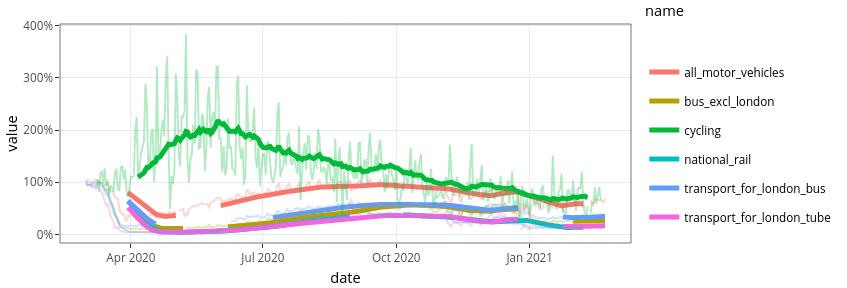Open source and participatory transportation planning
DERI Seminar, London, Zoom
Robin Lovelace, University of Leeds
Dustin Carlino, Alan Turing Institute
Companion slides: Google Slides
2023-01-26
Outline plan
1 Introduction to open tools for transport planning
Outline plan
1 Introduction to open tools for transport planning
2 Case study: A/B Street (Dustin)
Outline plan
1 Introduction to open tools for transport planning
2 Case study: A/B Street (Dustin)
We have 5 research groups
Working with TASM
Links with WYCA
Academic input
Sarah Sharples
Data can make a difference

Where I am now: PCT used by many in government
Too much data?
A nice problem to have?
Data historically a limiting factor
New approaches needed to tackle 'big noise'
Boyce, D.E., Williams, H.C.W.L., 2015. Forecasting Urban Travel: Past, Present and Future.
Too much data?
A nice problem to have?
Data historically a limiting factor
New approaches needed to tackle 'big noise'
Boyce, D.E., Williams, H.C.W.L., 2015. Forecasting Urban Travel: Past, Present and Future.

Lovelace, Robin, Mark Birkin, Philip Cross, and Martin Clarke. 2016. ‘From Big Noise to Big Data' https://doi.org/10.1111/gean.12081.
- For most of the history of transport planning data scarcity has been a major concern
- Now we have an abundance of datasets, many of them incompatible
- Concrete example: OD to WPZ data in central London (could ask if anyone knows, it's a mess hehe)
Problems worthy of your time
Problems worthy of your time
Ideas
Hackathons
Active travel
Road safety policy
Post COVID recovery
Levelling up metrics
Nature recovery networks
Citizen science and data literacy


Existing tools: The Propensity to Cycle Tool
- Early prototype of the tool developed at Open Data Institute Leeds hackathon, 2015
- National deployment of the Propensity to Cycle Tool 2 years later (PCT.bike) (Lovelace et al. 2017)

Key aspects of the PCT
- Based on open source code
- Based on open data
- Results published as open data
- Publicly available web application encourages participation and evidence-based debate
Open data and accessible results lead to participation. See https://twitter.com/search?q=cyipt.bike%2Frapid

How it works

So what's the overall approach here?
Thanks!
Thanks!
References
Thanks!
References
Lovelace, R., Goodman, A., Aldred, R., Berkoff, N., Abbas, A., Woodcock, J., 2017. The Propensity to Cycle Tool: An open source online system for sustainable transport planning. Journal of Transport and Land Use 10. https://doi.org/10.5198/jtlu.2016.862
Thanks!
References
Lovelace, R., Goodman, A., Aldred, R., Berkoff, N., Abbas, A., Woodcock, J., 2017. The Propensity to Cycle Tool: An open source online system for sustainable transport planning. Journal of Transport and Land Use 10. https://doi.org/10.5198/jtlu.2016.862
Morgan, M., Lovelace, R., 2020. Travel flow aggregation: nationally scalable methods for interactive and online visualisation of transport behaviour at the road network level. Environment & Planning B: Planning & Design. https://doi.org/10.1177/2399808320942779
Thanks!
References
Lovelace, R., Goodman, A., Aldred, R., Berkoff, N., Abbas, A., Woodcock, J., 2017. The Propensity to Cycle Tool: An open source online system for sustainable transport planning. Journal of Transport and Land Use 10. https://doi.org/10.5198/jtlu.2016.862
Morgan, M., Lovelace, R., 2020. Travel flow aggregation: nationally scalable methods for interactive and online visualisation of transport behaviour at the road network level. Environment & Planning B: Planning & Design. https://doi.org/10.1177/2399808320942779
Lovelace, R., Tennekes, M., Carlino, D., 2021. ClockBoard: a zoning system for urban analysis. https://doi.org/10.31219/osf.io/vncgw
Thanks!
References
Lovelace, R., Goodman, A., Aldred, R., Berkoff, N., Abbas, A., Woodcock, J., 2017. The Propensity to Cycle Tool: An open source online system for sustainable transport planning. Journal of Transport and Land Use 10. https://doi.org/10.5198/jtlu.2016.862
Morgan, M., Lovelace, R., 2020. Travel flow aggregation: nationally scalable methods for interactive and online visualisation of transport behaviour at the road network level. Environment & Planning B: Planning & Design. https://doi.org/10.1177/2399808320942779
Lovelace, R., Tennekes, M., Carlino, D., 2021. ClockBoard: a zoning system for urban analysis. https://doi.org/10.31219/osf.io/vncgw
Lovelace, Robin, Rosa Félix, and Dustin Carlino. “Jittering: A Computationally Efficient Method for Generating Realistic Route Networks from Origin-Destination Data.” OSF Preprints, January 13, 2022. https://doi.org/10.31219/osf.io/qux6g.



 Source: Morgan and Lovelace (
Source: Morgan and Lovelace (